Located at Little Island close to Cork City, this championship golf course is routed through exceptional golfing terrain, incorporating old limestone and red marble quarries and the inner reaches of Cork Harbour and Lough Mahon.
History
Cork Golf Club was founded in 1888. The first course was laid out at Rathcooney Hill just above Glanmire village. The terrain there was not very suitable. Being too hilly and rough, the primitive cutting equipment was just not able to cope. Within a short time the club moved to an area near Blarney where the landlord even offered them the use of a cowshed as a makeshift clubhouse. However, relationships between club and landlord were not always happy. The landlord insisted that no strong drink should be brought onto the lands. One bottle of whiskey was kept in the cowshed at weekends and when the landlord discovered this, virtual eviction was the inevitable result.

The 3rd par 4 short hole with Cork estuary behind
The club moved to its present location in 1897, when Messrs Moundsley & Sharman Crawford stumbled on the present piece of land, as they sailed up the Lee Estuary to compete in the Cork City Regatta. The land covered 87 acres and included a working limestone quarry established in the early 1800’s. Stone from the quarry was used in the walls of Cork City Hall. Three small specially built harbours can be seen when playing the 4th, 5th and 6th holes. These harbours were used to transport the stone to ships lying at anchor in the channel. The limestone was used as ballast for trans-Atlantic voyages and in America was sold off as building material. There are many buildings in Boston, in particular, which feature Little Island limestone featured.
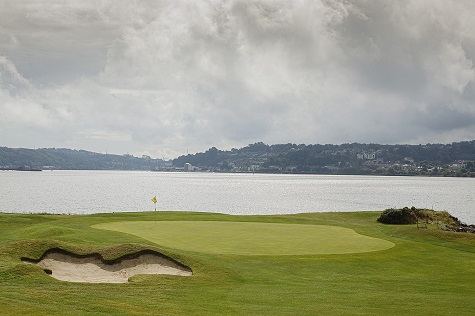
The 5th hole plays along the edge of the estuary
Work soon started on laying out five holes on a rough basis, but the work was slow. The quarry operations had left huge holes everywhere and these had to be filled with waste stone from the quarry. Later, a layer of top-soil had to be put down and in due course the grass grew.
The first Professional was David Brown from Edinburgh. He laid out the first 9 holes and the course, complete with clubhouse, located close to the present 8th tee, opened for play towards the end of 1898. His design for these holes was endorsed by the famous Harry Vardon who came to Cork to play an Exhibition Match in 1909. The same year saw the club purchase an extra 45 acres of land known as ‘The Park’ and by 1911, Cork Golf Club became an 18 hole course.
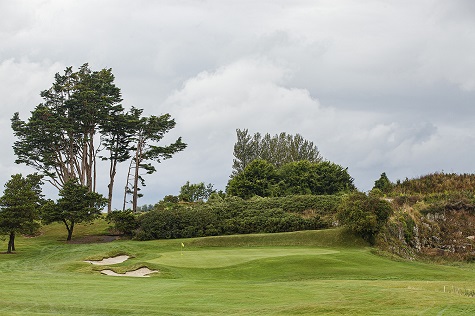
The par three 7th hole
In 1924/25 Cork Golf Club was fortunate to secure the services of Alister MacKenzie to re-design their existing course. MacKenzie is famous for designing Augusta National, home to The Masters golf tournament. Under the critical eye of his assistant Jack Fleming, MacKenzie drew up a design which made full use of the dramatic terrain. MacKenzie used the natural humps and hollows, and tied in artificial features so that they became an integral part of the course’s topography. Visitors cannot help but admire holes 6, 7, 8 and 9 as they are played in the bowels of the old stone quarry, which took hundreds of years to excavate. Work commenced early in 1924 and was completed in time for their first professional tournament in 1925. This course layout has remained almost unchanged to the present day.
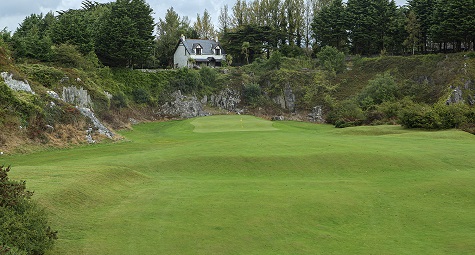
The 6th hole, also known as the quarry hole. Alastair MacKenzie put the quarry features to good use
The underlying limestone creates excellent natural drainage and a ‘links’ type environment on some holes, with alternate lush parkland on others. The river, with its ebb and flow, plays a major role on the 3rd, 4th and 5th holes. The steep chasms within the old quarry present an unforgettable golfing experience.
Cork Golf Club has hosted several major Amateur and Professional Championships over the years, including the 1932 Irish Open, Irish Professional Championships (1941 & 1963), Irish Close Championships and the National Finals.
In 2013 Cork Golf Club celebrated the 30th Anniversary of the memorable visit by Seve Ballesteros in 1983. Seve had just won the Carrolls Irish Open the previous day in Royal Dublin and the exhausted golfer kept his commitment in visiting the club. Appropriately a Spanish chestnut tree was planted opposite the spot where Seve’s ball landed on the 11th hole after he hit a monumental drive of 332 metres (363 yards). Not surprisingly he went on to birdie the hole. He completed the round in 68 shots. His playing partner on that day was Irish professional, Liam Higgins.
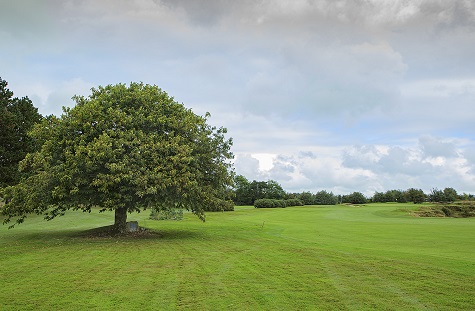
The Spanish chestnut marks the spot where Seve Ballesteros drove the ball on the 11th hole
Thankfully, the recession of 2008 did not adversely affect the membership numbers. It has remained steady since then and there are around 640 members covering all sorts of categories including men, ladies, juniors, clergy, and overseas.
Simon O’Hara is the Course Superintendent at Cork Golf Club. He came to the club in June 2018 after spending 19 years in nearby Fota Island Golf Club, which hosted the Irish Open on three occasions (2001, 2002, 2014). In his spare time Simon is an RNLI volunteer at Helvick Head.
2018 was a challenging year for Simon to begin his new role at Cork Golf Club as it was the beginning of the exceptional drought that the country experienced. Four hours each week, Simon gives greenkeeping lectures at a college in Cork called Coláiste Stíofáin Naofa (meaning St. Stephen’s College). Some of the greenkeeping students from the college come to Cork Golf Club to do their practical work there.
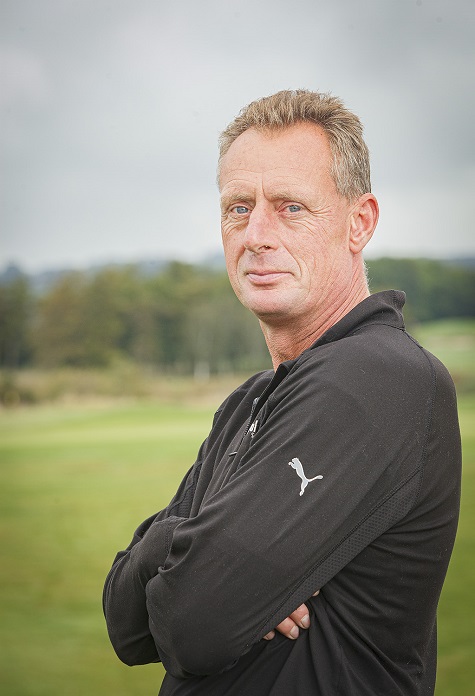
Simon O’Hara is the Course Superintendent at Cork Golf Club
Simon has already made his mark on the course. He has tastefully reshaped some of the green surrounds, in keeping with the MacKenzie design principals. “The rugged terrain, an outcome of the excavation works from the Quarries, provides a considerable challenge to simply drive our machines safely around the golf course. Some of the slopes near the greens are so severe that our machines would slide down the slopes in damp conditions or even in dew, creating several maintenance headaches for us” said Simon. “With the approval of the club we were allowed to soften some of these slopes. We were able to do this work in house with our outstanding greenkeeping team”.
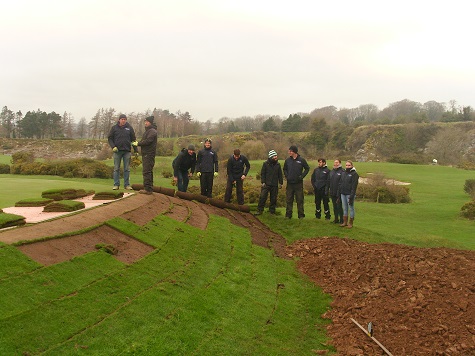
Works to the back of the 9th green to improve machine access and safety, with help from the Coláiste Stíofáin Naofa college greenkeeping students. Photo Simon O’Hara
“The quarry rock faces around the course are one of the club’s greatest assets, but the quarrying works also mean that we have lots of rock surfaces and outcrops that can hurt our machinery, as well as making it impossible to do any form of aeration in certain areas”. As well as reshaping areas of the course, Simon removed a lot of scrub along the 4th and 5th holes. By doing this it has opened up the view to the wonderful Cork Harbour.
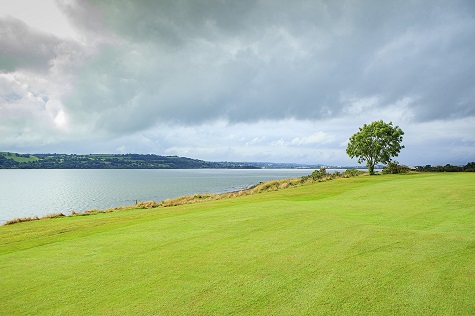
Clearing the scrub along the 4th and 5th holes allows for better views of Cork harbour
Simon has a natural eye for course design. A former 4 handicap golfer, he relishes the challenge of working on a Mackenzie designed course. He sees opportunities for further course improvements. He has also added a new tee on the 10th hole, bringing a scenic wetland more into view, adding the optical illusion of a greater carry than before, even though the new tee is the same length as before. “There are a lot of wonderful possibilities to make the course even more exciting and challenging”, said Simon.
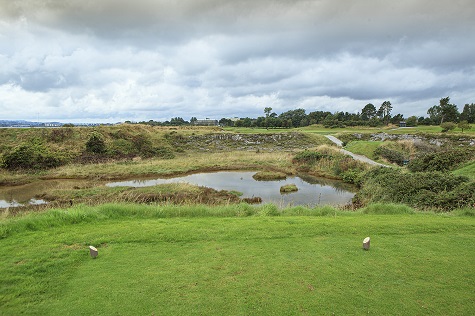
The newly positioned 10th tee box enjoys views of the scenic wetland, which must be carried to reach the fairway
Course Maintenance
Simon and his team maintain Cork Golf Club to the highest standards. There are six full time staff. In the summer an extra two or three people are hired to help with the busy maintenance schedule. The Greens are cut at 3mm during summer and 4mm in winter. Tees are mown at 8mm and the fairways at 13mm, increasing to 17mm in winter.
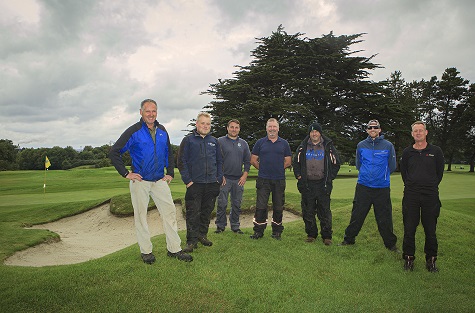
The greenkeeping staff from left: Jimmy Quirke, Alex Lehane, Steve O’Leary, Willie Corry, Charles Gillis, Dave Mackesy, Simon O’Hara
Two of the greens, the 5th and 12th, were constructed using USGA spec. sand rootzone. The remaining greens are soil based and fourteen of the soil based greens date back to the original Mackenzie design. These soil based greens can be prone to flooding from time to time. An overseeding with browntop and creeping bent grasses is regularly undertaken.
Simon believes that regular light sanding is a good way to keep thatch away from the greens and ensure that the course will always have firm green surfaces. The greens are pencil tined multiple times during the year, depending on weather conditions and plant health. The club recently purchased an Air 2 G2 aerator, which injects air at high pressure into the greens. Simon loves this method of aeration as it causes no disruption to play and can aerate down to 30 cm.
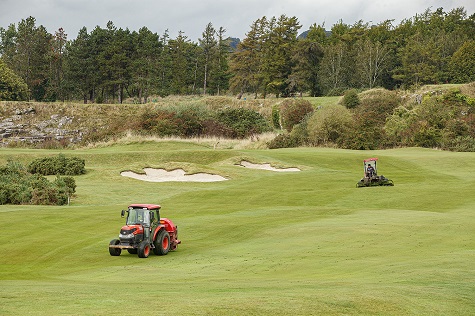
Operating in sync. The fairway mower is followed by the leaf blower, which disperses wet grass clumps
Feeding of the greens is kept to a minimum. “I like to keep the greens lean and mean but never sacrificing plant health” says Simon. Liquid feeding is given whenever it is needed, sometimes using liquid sulphate of ammonia. Liquid seaweed and iron is also used along with a growth regulator.
The fairways are given some nitrogen as needed. Primo Max is also applied on the fairways whenever it is required to ensure the best presentation and plant health.
With so much limestone under the soil, most of the fairways are naturally self draining. With the fairways being so dry, parts of the course, particularly around the quarry area, have a links feel about them, especially during hot dry spells in the summer.
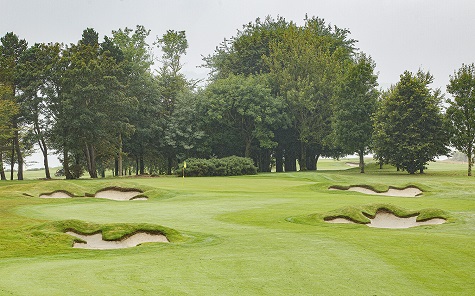
The 2nd green is guarded by tricky bunkers
Between 2010 and 2014, the course underwent a major revamp at a cost of €384,000. Work included building fourteen sets of tees; the reconstruction of the 12th green; redesigning and lining with SportBond the 52 bunkers dotted around the course.
The greens and tees have automatic irrigation, which is fed from three wells which top up a 25,000 gallon overground tank.
Wildlife
When you play golf at Cork Golf Club you will notice the odd pheasant during your round. Several years ago the club decided to buy in pheasant chicks and rear them so that they could be later released out onto the course. They did this for around three years, where the young pheasants had their own enclosure. Now the pheasants breed naturally within the environs of the course.
Many wild flora thrive around the course including different species of orchid.
When playing along the estuary you will often see a flock of cormorants basking on the old harbour walls. A pod of killer whales were even seen in the estuary in 2002.

Pheasants freely roam around the course
Simon and his team have cleared much of the scrub around the quarry area on the 7th hole, and have started creating a wetland area, populated by yellow flag Iris and rushes and reeds, in part of it. This will be completed this winter. Another future project includes the removal of the ivy and vegetation from the quarry rocks so that the dramatic limestone rock faces can be revealed, enhancing the visual experience. He also hopes to clear the scrub and replant the area in the red marble quarry, which is in front of the men’s 2nd tee.
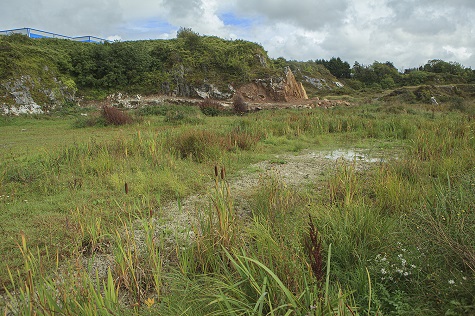
Part of the quarry has been used to create a wetland area. Plans are in place to remove the vegetation on the rock face to reveal the dramatic limestone rock
It was a great experience going around the golf course with Simon. With the views over the harbour and the quarry area there was a lot of diversity within the course. This course is a jewel in Little Island.